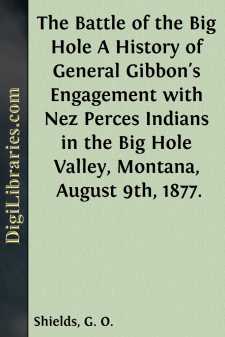Categories
- Antiques & Collectibles 13
- Architecture 36
- Art 48
- Bibles 22
- Biography & Autobiography 813
- Body, Mind & Spirit 142
- Business & Economics 28
- Children's Books 14
- Children's Fiction 11
- Computers 4
- Cooking 94
- Crafts & Hobbies 4
- Drama 346
- Education 46
- Family & Relationships 57
- Fiction 11829
- Games 19
- Gardening 17
- Health & Fitness 34
- History 1377
- House & Home 1
- Humor 147
- Juvenile Fiction 1873
- Juvenile Nonfiction 202
- Language Arts & Disciplines 88
- Law 16
- Literary Collections 686
- Literary Criticism 179
- Mathematics 13
- Medical 41
- Music 40
- Nature 179
- Non-Classifiable 1768
- Performing Arts 7
- Periodicals 1453
- Philosophy 64
- Photography 2
- Poetry 896
- Political Science 203
- Psychology 42
- Reference 154
- Religion 513
- Science 126
- Self-Help 84
- Social Science 81
- Sports & Recreation 34
- Study Aids 3
- Technology & Engineering 59
- Transportation 23
- Travel 463
- True Crime 29
The Battle of the Big Hole A History of General Gibbon's Engagement with Nez Perces Indians in the Big Hole Valley, Montana, August 9th, 1877.
by: G. O. Shields
Description:
Excerpt
CHAPTER I.
The Nez Percé Indians are a powerful and populous tribe, who, for centuries, have made their home in the Snake, Salmon, and Clear Water Valleys in Washington, Oregon, and Idaho. When the great tide of civilization, which for years flowed toward the Pacific Coast, finally spread out into these valleys, questions arose between the emigrants and Indians as to the ownership of certain lands claimed by the latter, and the United States Government sought to settle these questions amicably. Commissioners were appointed and sent out to investigate and define the rights of the Indians, and in 1853, a treaty was concluded between the United States and the head chiefs and fifty-two of the principal men of the Nez Percé tribe, defining the boundaries of the country claimed by them, and ceding to the Government certain other lands which they had formerly occupied, but to which they had set up no valid claim.
In 1863, another treaty was made, modifying these boundaries to some extent, and in 1868, still another was negotiated at Washington that was finally signed by "Lawyer," head chief of the Nez Percés, and by "Timothy" and "Jason," sub-chiefs, all of whom claimed to be, and in fact were, acting for the entire tribe by virtue of authority given them by the tribal laws, and by a general council of their people assembled for that purpose.
In this treaty, the Indians agreed, for certain considerations that were entirely satisfactory to them, to relinquish certain portions of their reservation which they agreed were not needed or used by them, and to remove from said lands within one year from that date; to locate and live upon the reservation therein designated and described.
CHIEF JOSEPH.
The tract relinquished to the United States in this instrument included the Wallowa Valley. When the chiefs returned to their people and reported their action, Young Joseph repudiated the treaty, and refused to be bound by it. He claimed the Wallowa Valley as the special home and inheritance of himself and his people, and said he would continue so to claim it, and to occupy it whenever he chose, against all other claimants, white or red.
In this dissension he was in time joined by White Bird, Looking Glass, To-hul-hul-sote and other sub-chiefs, and several hundred warriors. These became known henceforth as the "Non-treaty Nez Percés." Joseph and his band had never really occupied the valley permanently, and had never before made any special claim to it as against any other portion of the tribe. He had frequently gone into it during the summer to fish and hunt, in common with various other bands of the tribe, but had never staid more than a few weeks at a time, and had made his home during the greater portion of each year in the Imnaha Valley near the Snake River.
In 1871, a few whites settled in the Wallowa Valley. Joseph protested, became obstreperous, ordered them away, and threatened violence if they remained, but so far did nothing more than threaten. Other whites came in the following years and the complications increased....


